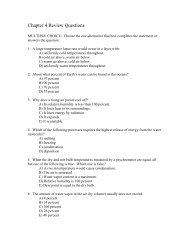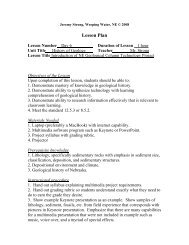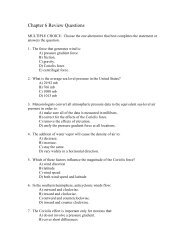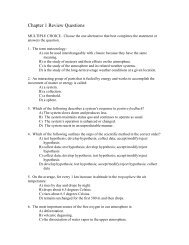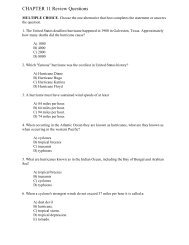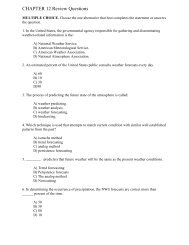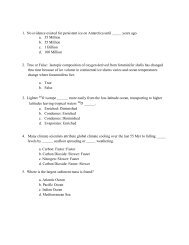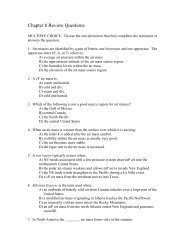Interpreting the Sedimentary Rocks at
Interpreting the Sedimentary Rocks at
Interpreting the Sedimentary Rocks at
Create successful ePaper yourself
Turn your PDF publications into a flip-book with our unique Google optimized e-Paper software.
<strong>Interpreting</strong> <strong>the</strong> <strong>Sedimentary</strong> <strong>Rocks</strong> <strong>at</strong> ____________________Step 1: Describe <strong>the</strong> texture and composition of <strong>the</strong> clastic (detrital) rocks.A. Grain/clast sizeRounded grainsConglomer<strong>at</strong>eGravel Grains >2 mmAngular grainsBrecciaGeneral termSandstoneSandGrains
Step 2: Look for <strong>the</strong>se physical fe<strong>at</strong>ures to try to figure out <strong>the</strong> depositional environment.A. Rock ColorOxygen-poor, stagnant settings and high organicBlack Enriched in organic m<strong>at</strong>ter & pyrite (FeS 2 ) productivityCoal swamp or restricted basinOxidizing conditions, often associ<strong>at</strong>ed withRed Enriched in iron oxides such as hem<strong>at</strong>ite (Fe 2 O 3 ) subaerial exposure & hot arid clim<strong>at</strong>es.Terrestrial or shallow marineB. Surface markingsRipple Small-scale ridge of sandEnvironment was affected by flowing w<strong>at</strong>er, waveaction, or wind motione.g., river, estuary, sand dunePolygonal-shaped cracks formed in mud th<strong>at</strong> has Environment affected by altern<strong>at</strong>ing wet and dryMudcrackdried out in a terrestrial environmentconditionsTidal fl<strong>at</strong>, lake shore, desertC. Internal bedding fe<strong>at</strong>uresSettling of sediment in suspensionLamin<strong>at</strong>ionLake: Seasonal deposition of fine (winter) andVery fine layering composed of discrete layerscoarse (summer) sedimentof sediment a millimeter or so in thicknessMarine: Indic<strong>at</strong>es lack of bioturb<strong>at</strong>ion and<strong>the</strong>refore stressed conditions, e.g., low oxygen.GradedbeddingEnvironment was affected by flowing w<strong>at</strong>er, waveaction, or wind motione.g., river, estuary, sand dune (large-scale cross-beds)Deposition in environment where current flowvaries considerablyTidal fl<strong>at</strong>, estuaryCrossbeddingHeterolithicbeddingConvolutebeddingUpward grad<strong>at</strong>ion in grain size from coarseror finer m<strong>at</strong>erialFormed by <strong>the</strong> migr<strong>at</strong>ion of <strong>the</strong> slip-faces ofripped bedforms or dunesClosely interbedded deposit of sand and mudFolds whose intensity dies out both upwardsand downwards within a single bedFining-upward - deposition from a waning current(turbidity flow)Coarsening-upward – deposition underincreasingly high energy conditions (environmentis shallowing)Subjection of w<strong>at</strong>er-rich sediments to an exteshock (earthquake, large waves)Step 3: Check yourself by rea ding about <strong>the</strong> depositional environmentyou inferred.EnvironmentCommonLithologies<strong>Sedimentary</strong> StructuresFossilsTerrestrial Sandstone Unidirectional ripples and/or RareRivercross-bedding; channel forms incross-sectionTerrestrial Mudrock, shale, None or lamin<strong>at</strong>ion; evidence for Plant rootlets; coaly seams,Floodplain siltstonesoil developmentplant debrisTerrestrial Mudrock, shale, None or lamin<strong>at</strong>ionRare; microscopic fossilsLake siltstone, limestone Bioturb<strong>at</strong>ion on bed surfaces such as di<strong>at</strong>omsTerrestrialRipples; large-scale crossbeddingSandstoneSand duneRareRipples and/or cross-bedding; Often rare; organisms th<strong>at</strong>Coastalchannel forms in cross-section can withstand brackishSandstoneEstuaryEvidence for tidal influence;conditionsBioturb<strong>at</strong>ionMudrock, shale,Common; organismsth<strong>at</strong>Offshore/shelf siltstone; sandstoneinterbeds possibleCommon bioturb<strong>at</strong>ionrequire normal marineconditions to livernal



